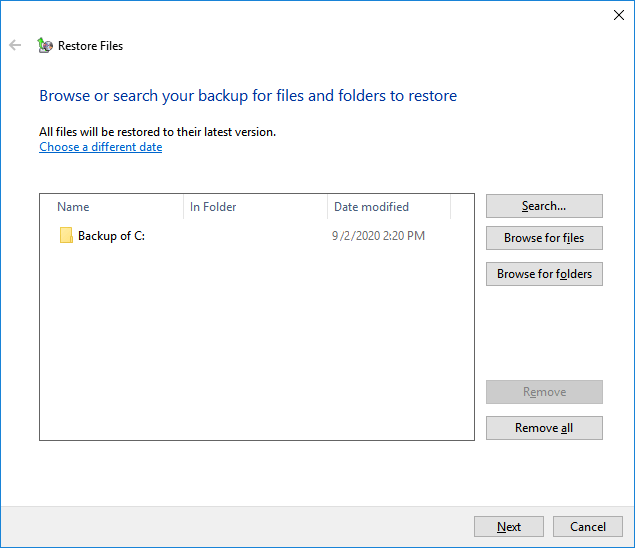Method 1: Folder Previous Version Restore
The first method for recovering permanently deleted files is using the previous version restore on Windows 10. This requires, though, that you have your File History back up set up on your Windows PC. If you do not have this feature configured to regularly back up or maintain the history of certain files or folders on your computer then you will not be able to recover them using this method. If you do, then carry out the steps listed below:
Method 2: File Recovery Tool
If you do not have File History configured on your Windows PC, you can use a File Recovery Tool or Client to recover your accidentally permanently deleted file. This method does not require prior setup or configuration and can simply be carried out to the same effect as the File History restoration method discussed earlier. The particular software we used for this is the EaseUS Data Recovery Wizard due to its wide recovery range. It can recover anything that you have permanently deleted from an internal drive, an external hard drive or storage device, and from the Recycle Bin. You do not have to use this particular recovery tool and can use any other one you see fit. To go about using this particular recovery tool (for the purpose of this guide), however, you will first need to download and install it. The EaseUS Data Recovery Wizard is available for download on Windows from the following link: download. Once you download the file, run its installer and follow the on screen instructions until the application is launched and ready to go. Once you have your tool started, carry out the following steps:
Method 3: Windows Back Up
If you have created a Windows or external drive back up at any point in time, you can recover your recently permanently deleted files and folders by restoring your Windows or external drive to a point in time at which those files and folders were not deleted. To do this, carry out the following steps:
Is Permanently Deleted File Recovery Time-Bound?
The good news when it comes to recovering a file or folder that was permanently deleted is that your recovery period is not time sensitive. You are not limited to only recovering permanent deletes of the last 24 hours or the last week or month or even year. Whenever you permanently delete a file or folder from your hard drive, it removes the file from your mapping database so that you can no longer see, access, or change it, but that file still exists somewhere on your drive. Over time, the health of these deleted files does deteriorate so the longer you wait, the lesser your chances becoming of successfully recovering a file. However, there is no direct correlation with time as explained earlier. You can attempt a recovery from the last hour or the last 6 months and depending on the health of that file at that point, you’ll be able to make your restoration.
How To Prevent Accidental Permanent File Deletion
It is highly recommended that you configure the following two mechanisms on your Windows PC: “File History” and “Backup & Restore.” Configuring both and regularly updating or recreating restore or backup points will keep your computer safe by always providing you with a reasonable and recent backup or restore point to return to. With “File History,” you can create these restoration points for specific files and folders. It is recommended that you create these for the main files and folders that you use and make changes to often so that their changes are tracked and maintained in the file history for recovery. The “Backup & Restore” feature allows you to create larger scale backup points for your entire computer or particular drives such as the C or D drives on your PC. It is recommended to configure and update both regularly so that you ae able to use Methods 1 & 3. If you do not, those two methods are ruled out for you entirely and are unusable.
Final Thoughts
The three methods outlined above provide three distinct ways for you to recover lost or permanently deleted files and folders. Based on whether you’ve set up your “File History,” your “Backup & Restore,” or neither, you can use Methods 1, 3, and 2, respectively. For methods 1 and 3, you must set up those restore points to be able to return to them in the future and it is recommended that you do for your data’s safety. Method 2 allows you to use a third party application to recover deleted content. We strongly suggest that you rely on methods 1 & 3 as those are the in-built and most reliable Windows functions vesus Method 2.
How to Recover Data from a Faulty Hard DiskHow to Recover Deleted Instagram Messages through Download DataFix: No Hard Drives Found in Windows 7 InstallerNew PlayStation 5 With Detachable Disc Drive Planned for 2023



